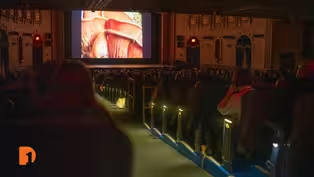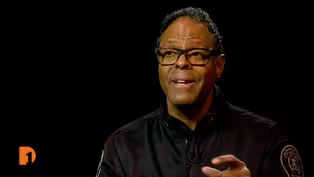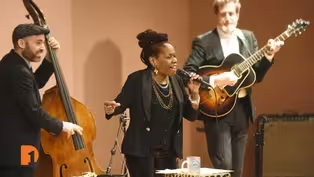
Charles H. Wright Museum celebrates 60 years of Black history and culture in Detroit
Clip: Season 9 Episode 38 | 5m 51sVideo has Closed Captions
The Wright Musuem’s Kevin Davidson discusses the history of the museum for its 60th anniversary.
The Charles H. Wright Museum of African American History celebrates its 60th anniversary in 2025. Established in 1965 by Dr. Charles H. Wright and 32 community members, the museum is a cornerstone of Detroit’s cultural and educational landscape. One Detroit contributor Stephen Henderson talks with Director of Design and Fabrication Kevin Davidson about the museum’s history and Dr. Wright’s legacy.
Problems playing video? | Closed Captioning Feedback
Problems playing video? | Closed Captioning Feedback
One Detroit is a local public television program presented by Detroit PBS

Charles H. Wright Museum celebrates 60 years of Black history and culture in Detroit
Clip: Season 9 Episode 38 | 5m 51sVideo has Closed Captions
The Charles H. Wright Museum of African American History celebrates its 60th anniversary in 2025. Established in 1965 by Dr. Charles H. Wright and 32 community members, the museum is a cornerstone of Detroit’s cultural and educational landscape. One Detroit contributor Stephen Henderson talks with Director of Design and Fabrication Kevin Davidson about the museum’s history and Dr. Wright’s legacy.
Problems playing video? | Closed Captioning Feedback
How to Watch One Detroit
One Detroit is available to stream on pbs.org and the free PBS App, available on iPhone, Apple TV, Android TV, Android smartphones, Amazon Fire TV, Amazon Fire Tablet, Roku, Samsung Smart TV, and Vizio.
Providing Support for PBS.org
Learn Moreabout PBS online sponsorship(gentle bright music) - Let's start with your history with the Wright, which goes back quite a ways.
Not quite 60 years, but the majority of that, right?
How did you come to the museum?
- I actually was introduced to the museum in 1980, and I was on loan, placed on loan to the museum from the Detroit Council of the Arts at the time to work on an exhibit that focused on Black insurance companies.
And we completed that project and, you know, I went on, and I got a call from the museum in 1982.
And Dr. Wright wanted me to come in and work on an exhibit on Black voting rights.
And so I met with him and he gave me a book and said, you know, "This is something that you're gonna extract your script from."
I remember the author's name was Holt.
I can't remember his first name.
I think it was Robert Holt.
And so from there, he kind of paired me with one of the longtime volunteers, Margaret Zarif.
And she collected images.
I did some additional research and designed and installed that exhibit on voting rights.
- Yeah, yeah.
- And he loved it.
- And he hired you.
- Yeah.
- And so- - And you've been there since.
- Right.
And he invited, he said, "I need you to do one on Charles Drew."
And I did that.
And then he asked me to redesign the mobile unit, which traveled over all around the state.
And so I did that and he said, "Well, you know, you may as well stick around."
- [Stephen] Like, "We're gonna keep you here."
- Yeah.
- Talk about in those early days, though, what the museum was like and how different it is now.
I mean, now it's basically a like a monument, right?
I mean, it's this wonderful physical space.
Back then, it was a little more understated.
- Yeah, it was located first in the basement of a three-row house on West Grand Boulevard and Warren, right on the corner.
It was Dr. Wright's residence, you know?
He and his family lived there.
And so when he founded the museum, he set up exhibits in the basement.
He eventually moved out, moved downtown, and basically went in and converted all of those spaces to gallery spaces.
So, so when I started, part of my job too was to convert some spaces.
So I worked with a carpenter, and we went in and, you know, tore out walls and, you know, did some plastering.
And I converted some spaces, and so I started installing exhibits.
It's a house.
It's a three-row house, so, you know, when we had tours, you know, you had to take 'em up the stairs, into the gallery, back out, and into the next building, and back out, and then into the next building, and back out.
Dr. Wright's sister volunteered with us at the time, Pearl Battle, and it was the two of us, you know, conducting these tours through the building.
And, you know, we went from that to a structure that we built from the ground up in the cultural center that's occupied by CCS now on the corner of Frederick Douglas and Brush.
And even before we moved into that building, plans were already underway for the Phyllis facility we're in right now.
- [Stephen] Yeah, for the museum itself that everyone is so familiar with now.
- [Kevin] Yes, yeah.
- Talk about the difference between making exhibits in the basement of a three-row house and the space you have now.
I'm thinking of the Jefferson exhibit that was there just a few years ago.
- [Kevin] Oh, yeah.
- The wonderful art and the costume exhibit that was there last year.
I mean, these are large scale kinds of exhibits now.
Very different from being in a basement.
- It's a different world.
(both laughing) You know, everything had to be put together by hand and I'm taking little litters and creating, you know, these introductory panels and, you know, everything had to be constructed by hand back then.
More time consuming.
You know, we were doing key lines for prints and all of that.
And so it's a different world.
And, of course, you know, when you compare just, you know, the space, you're talking about, you know, a bathroom versus a mansion.
- Right, right.
- You know?
But along with the change in facilities, you know, you can bring in contractors.
And so that's part of what I do, is, you know, do the elevations and floor plans and construction drawings and they take those and, you know, build these platforms, cases and- - [Stephen] I mean, they're experiences.
- Yeah, yes.
- I mean, I always feel like you're walking through the subject matter when I'm there.
- That's our goal.
- Yeah.
- You know, and I worked on our core exhibit being Still We Rise and we wanted to make that fully immersive.
And so we certainly achieved that with that exhibit, and, you know, we continue to pursue that.
- [Stephen] Yeah.
Detroit filmmaker shares preview of 63rd annual Ann Arbor Film Festival
Video has Closed Captions
Clip: S9 Ep38 | 7m 12s | Preview the 63rd annual Ann Arbor Film Festival taking place March 25-30 at the Michigan Theatre. (7m 12s)
Detroit’s new police chief discusses the city’s community violence intervention
Video has Closed Captions
Clip: S9 Ep38 | 7m 15s | Detroit Police Chief Todd Bettison talks about the city’s community violence intervention program. (7m 15s)
One Detroit Weekend | Things to do around Detroit this weekend: March 21, 2025
Video has Closed Captions
Clip: S9 Ep38 | 2m 3s | “One Detroit Weekend” shares upcoming events happening around Detroit this weekend and beyond. (2m 3s)
Providing Support for PBS.org
Learn Moreabout PBS online sponsorship
- News and Public Affairs

Top journalists deliver compelling original analysis of the hour's headlines.

- News and Public Affairs

FRONTLINE is investigative journalism that questions, explains and changes our world.












Support for PBS provided by:
One Detroit is a local public television program presented by Detroit PBS


